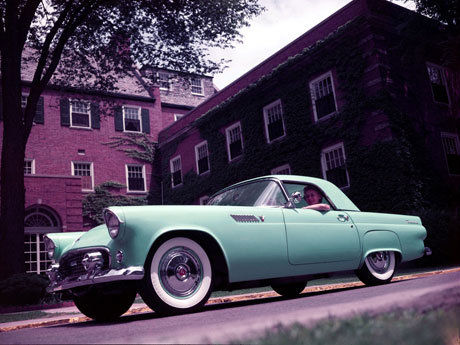
The immediate post-war era saw sports cars enter the American consciousness for the first time since the days of the Mercer Raceabout and the Stutz Bearcat. By the early 1950s-in addition to foreigners like MG, Jaguar, Aston Martin, and Ferrari-Ford had to stomach American independents and upstarts dabbling in sports cars, most notably tiny manufacturers like Kaiser, Hudson, Nash, Crosley, Kurtis, and Muntz. The final straw came when arch rival Chevrolet introduced the Corvette in June of 1953, though really, the Thunderbird story started a few years before that with a subordinate's fib to his boss.
It all started in Paris
Lewis Crusoe, a Ford exec, and George Walker, Ford's chief stylist at the time, were attending an auto show in Paris. History doesn't record what sports car on whose stand he was looking at, but Crusoe remarked accusatorily to Walker, "Why don't we have anything like that?" Although knowing full well that nothing was in the works, Walker represented that his team was working on "something."
Before returning to Dearborn, Walker contacted designer Frank Hershey and told him to get to work on a Ford sports car. The Corvette's introduction added a sense of urgency, and Henry Ford II gave the project his official blessing after the 1953 Los Angeles Autorama. The Thunderbird's introduction in the fall of 1954 was fortuitous. The Korean War was over, the economy was in good shape, and Chevrolet's Corvette was a fiberglass flop, its six-cylinder engine and annoying side curtains simply not cutting the mustard. And for the whole of 1955, the T-Bird outsold the Corvette nearly 25-to-1.
The T-Bird, with its Mercury-sourced 292-cubic-inch V8 and roll-up windows, plus a host of other available convenience options, seemed to fit most Americans' idea of what a sports car should be. In reality, however, it was no such thing. "Sports" spelled "personal luxury" was more like it. With the exception of the aforementioned Y-block V8, the T-Bird's engineering was conventional been-there-done-that Dearborn for the period. Separate body and chassis, four-wheel drum brakes, and a 3-speed floor shift manual transmission or a Ford-O-Matic autobox.
Braking and handling were a bit better than, say, a Crown Vic of the era, but only by virtue of the T-Bird's lighter weight. Marginal handling became truly manic in 1956, when Ford moved the spare from the trunk to free up more golf club and picnic hamper space and plopped it on the rear bumper for all to admire. On wet roads, heavy-tail-induced oversteer could become quite scary, so the wheel and tire were moved back into the trunk for 1957.
That year also brought the first real styling and powertrain changes, although still within the so-called First Generation. A larger grille and front bumper and larger canted fins in the rear were a bit of a mixed bag. Some prefer the '57 and some despise it. A 245-hp 312-ci V8 became standard, and twin Holley four-barrel E-Birds and supercharged cars are rare and quite desirable. Straight-line performance of any flavor of T-Bird is quite decent.
Ownership requirements
Thunderbird ownership presents few challenges. They rust with the best of them, but repair panels are readily available, as are mechanical and trim parts. They're robust and reliable and make nice sunny day cruisers or tour cars for undemanding roads. Ride quality is excellent, and convenience items like a powerful heater and signal-seeking radio are great, but the steering is vague and for a relatively compact car, it's hard to place in corners. Not that you'd want to engage in spirited cornering anyway with just a slippery bench seat to hold you in place. Compared to contemporary Alfa or even Corvette drums or TR3A discs, a T-Bird's brakes are simply miserable. Disc conversions exist and are worth considering for anyone who drives his car in anything other than the annual Optimists Club parade.
The Thunderbird market has been in transition lately. Like Tri-Five Chevys, prices have been stagnant at best, and those of mediocre cars are way down from several years ago. Since there's no shortage of classic T-Birds and prices even for good cars are down, there's no reason to consider anything but a no-stories car.
The fact of the matter is that the market for 1955-57 Thunderbirds is aging-those who wanted them as teenagers in 1955 were born before the war, and Boomers and subsequent generations haven't taken the same shine to them. This doesn't mean they never will; they just aren't right now. A pity, as Thunderbirds are stylish potential daily drivers and ideal first-time collector cars, even if you'll never bring home a gymkhana trophy with one.
